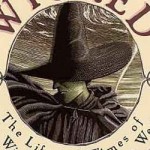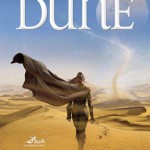Wicked: The Life and Times of the Wicked Witch of the West by Gregory Maguire
Move over, Dorthy, this isn’t your mother’s Wizard of Oz. In fact from the beginning it doesn’t even look much like the Oz we grew up with at all. Whether you grew up with the books by L. Frank Baum or the film adaptations, you’ll certainly recognize certain places and people, but you will be seeing them in a whole new light–a green one. Wicked follows Elphaba, the green skinned and misunderstood young woman who eventually becomes the Wicked Witch of the West, from her childhood through her death at the hands of Dorothy.
While I find it is almost always interesting to hear a story from another point of view, this one focuses more on who and what is right and wrong, good and evil. It points out that just because something is different doesn’t mean it’s bad, and just because something is beautiful doesn’t make it good. These themes are scattered throughout the book. Elphaba may have green skin, but she fights for the rights of all people and Animals (sentient and speaking animals, a la The Lion), no matter what they look like, and against following the blind authority of the Wizard. Galinda (and later on Glinda) is snobby, inconsiderate, and initially judges Elphaba based solely on her looks.
Elphaba and Galinda initially meet after being forced to be roommates at Shiz University, where they are immediately at odds. Galinda comes from a high society family and Elphaba is, well… green. When Galinda tries to humiliate her roommate with what was supposed to be an ugly hat, which actually looks quite good on Elphaba, they begin to talk and get to know one another, and Elphaba teaches Galinda that she needs to think about things more seriously, rather than just accepting things as they are.
The book also focuses on a theme very familiar to many of us, and that is race discrimination. However, it’s not quite what you would think. The point isn’t made as much through Elphaba but through the Animals / animals conflict, (when spelled with a capital letter meaning they are sentient). Doctor Dillamond, a Goat, lectures to his students (including Galinda and Elphaba) about the difference between the two and says that Animals really have more in common with humans than with animals and should not be treated like second rate citizens. However under the rule of the Wizard of Oz, this is becoming the case.
The story turns dark when Doctor Dillamond dies suspiciously, and Elphaba, Nessa (Elphaba’s younger armless sister), and Glinda (who changed her name after the Doctor’s death) are made into pawns of the Wizard. This effects all of them a little differently, but Elphaba is affected the most. She decides that she can no longer remain at school and removes herself into hiding where she continues the doctor’s study of Animals in private.
The story is compelling, filled to the brim with intrigue and ideas that you wouldn’t have ever gotten from the original books or films. Without possibly spoiling any more of the book I will say is a must read. It’s not the light fluff of the movie, and it is certainly worth reading. The darker tones only help to suspend disbelief and it is easy to understand the motivations of the different characters involved and see how they grow and change. We see Glinda starting to think on her own, Nessa growing up as a devout unionist into the Wicked Witch of the East, and Elphaba standing up for what she believes in and having the public machine turn against her.
I couldn’t put this book down. There are some emotionally difficult parts and scenes that you wouldn’t expect from the lovable land of Dorothy, but this isn’t Kansas anymore, and this isn’t the Oz you thought you knew. This is a darker look, a more “real” look, and truly a more heartfelt look at Oz. And if you didn’t like the dark parts of the book but liked the story, you can always check out the Broadway musical, which isn’t the book but is also very amazing.
“No good deed goes unpunished”
-Kelly Melcher







